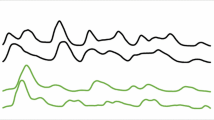Abstract
A long term goal of research in artificial intelligence is todetermine and to implement principles which permit a movable machine to direct its actions depending uponsensory feed-back from its environment. This paper concentrates onspatial sensors which input images (2-dimensional arrays). A proposal is put forward in which the machine adaptsto the actual data, and examplesare given of input prediction, of detection of unexpected events, andof recognition of spatial patterns.The image sequence is locally partitioned into temporally contiguous subsequences of afixed spatial extent. The spatial extent is constant over time and the temporal extent of a subsequence is maximizedsubject to the condition that the subsequence has occurred previously. The principle is illustrated on image sequences. It is further demonstrated on images which are structured as pseudo-temporal sequences of their rows. The demonstrations use diverse complex and simple examples to illustrate theversatility of the method. The demonstrations show that to a large degree it is not necessary for the user to supply explicit models for different patternrecognition tasks.
Similar content being viewed by others
References
T.C. Bell, J.G. Cleary, and I.H. Witten, Text Compression, Prentice Hall, 1990.
P. Brodatz, A Texture Book, Dover Publications, 1966.
Peter Johansen, “On-line string matching with feedback,” Theoretical Computer Science, pp. 53–67, April 1995.
Y.C. Leclerc, “Constructing simple stable descriptions for image partitioning,” International Journal of Computer Vision, Vol. 3, pp. 73–102, 1989.
Abraham Lempel and Jacob Ziv, “On the complexity of finite sequences,” IEEE Transactions on Information Theory, Vol. 22, pp. 75–81, 1976.
Abraham Lempel and Jacob Ziv. “Compression of twodimensional data,” IEEE Transactions on Information Theory, Vol. 32, No.1, pp. 2–8, 1986.
Li and Vitanýi, An Introduction to Kolmorogov Complexity and its Applications, North Holland, 1993.
Tony Lindeberg, Scale-Space Theory in Computer Vision, Kluwer, 1994.
Tony Lindeberg and Meng-Xiang Li, “Segmentation and classification of edges using minimum description length approximation and complementary junction cues,” in Proceedings of the Ninth Scandinavian Conference on Image Analysis, G. Börjefors (Ed.), 1995.
E.M. McCreight, “A space-economical suffix tree construction algorithm,” Journal of the ACM, Vol. 23, pp. 262–272, 1976.
Mads Nielsen, “From paradigm to algorithms in computer vision,” Ph.D. thesis, DIKU, Datalogisk Institut ved Københavns Universitet, Copenhagen, Denmark, DIKU-95-8. April 1995.
William B. Pennebaker and J.L. Mitchell, JPEG Still Image Data Compression Standard, Van Nostrand Reinhold, 1993.
Jorma Rissanen, “A universal data compression system,” IEEE Transactions on Information Theory, Vol. IT-29, pp. 656–664, 1983.
Jorma Rissanen, Stochastic Complexity in Statistical Inquiry, World Scientific, 1989.
M. Rodeh, V.R. Pratt, and S. Even, “Linear algorithm for data compression via string matching,” JACM, Vol. 28, pp. 16–24, 1981.
Jon Sporring, “Pruning with minimum description length,” in Proceedings of the 5th Scandinavian Conference on Artificial Intelligence (SCAI’95), Trondheim, Norway, May 29–30, 1995, pp. 157–168.
E. Ukkonen, “Online construction of suffix trees,” Algoritmica, Vol. 14, No.3, pp. 249–260, Sept. 1995.
P. Weiner, “Linear pattern matching algorithms,” in 14th Annual Symposium on Switching and Automata Theory, pp. 1–11, 1973.
Ross Whitaker and G. Gerig, “Vector-valued diffusion,” in Geometry-Driven Diffusion in Computer Vision, Bart M. der Haar Romeny (Ed.), pp. 93–134. Kluwer, 1994.
Ross N. Williams. Adaptive Data Compression, Kluwer Academic Publishers, 1991.
S. Wolfram, “Cellular automata as models of complexity,” Nature, p. 311, 1984.
Author information
Authors and Affiliations
Rights and permissions
About this article
Cite this article
Johansen, P. Adaptive Pattern Recognition. Journal of Mathematical Imaging and Vision 7, 325–339 (1997). https://doi.org/10.1023/A:1008207228099
Issue Date:
DOI: https://doi.org/10.1023/A:1008207228099




